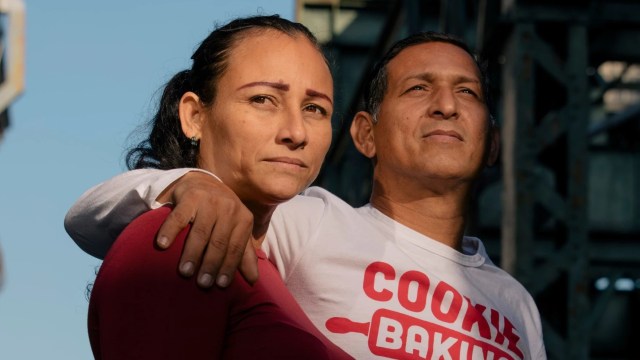
When Víctor Villegas and Milagros Pineda arrived in New York in early August, they tried to go to a homeless shelter for couples.
By WLRN – Marisa Peñaloza
Oct 19, 2022
But they were turned away, because they’re not legally married. In order to stay together at the shelter, the couple needed some paperwork. On top of that, it was Sunday – and they couldn’t get the paperwork they needed until Monday.
“We basically felt lost, without money and in the streets,” Villegas said in Spanish.
Like many of the Venezuelan migrants crossing the southern border right now, Villegas and Pineda didn’t have any money, or any family or friends anywhere in the U.S. they could call for help.
The Biden administration has announced an agreement with Mexico aimed at reducing the record number of Venezuelan migrants crossing the border illegally. That deal includes a new legal pathway for up to 24,000 Venezuelans — if they can find a financial sponsor in the U.S.
But immigration experts say that won’t be easy for many Venezuelans.
“They’re starting over in very precarious circumstances,” said Andrew Selee, the president of the Migration Policy Institute, a nonprofit in Washington, D.C., “because they don’t have the social networks in the United States that other migrants generally do.”
Trying to figure things out on their own
Villegas says he and Pineda came to New York because they didn’t know where else to go. They had heard good things about the city from other migrants, they said, and the shelter in Texas where they were staying offered them free bus tickets.
After they were turned away from the couples shelter in New York, Villegas and Pineda called the phone number of some volunteers who had met their bus. They let Villegas and Pineda stay with them until the couple could get their paperwork issues fixed.
Two months later, Villegas and Pineda are staying in a homeless shelter on a gritty block in Brooklyn. And in many ways, they are still lost.
They don’t have work permits. They don’t understand the immigration system. They have been able to work a little bit: Villegas has done some demolition, while Pineda is occasionally cleaning houses.
But it’s not enough.
“We are alone, trying to figure things out,” Villegas said.
The latest wave of Venezuelan migrants is very different from Mexican and Central American migrants who’ve come before, says Selee. Those migrants usually have friends or family in the U.S. and have talked to them before they arrive.
“They know whose couch they’re going to sleep on. They know who’s going to help them try to get their first job or maybe has already gotten that first job for them. The Venezuelans don’t seem to be part of that planned migration,” Selee said.
That put an additional strain on the homeless shelter system in New York City, which was already struggling. New York Mayor Eric Adams declared a state of emergency earlier this month, as the city is preparing several temporary relief centers to house newly arrived migrants.
“We need help. And we need it now,” Adams said in a speech at City Hall.
This mass migration of Venezuelans is relatively new for the U.S., but it’s been happening for several years in Latin América. U.S. officials say nearly 8 million people have left Venezuela – more than a quarter of the population – to Colombia, Perú, Ecuador and Chile, as the country’s economy has collapsed under its authoritarian government and the impact of U.S. sanctions.
“We endured so much, for so long we tried to make things work, but couldn’t stay in Venezuela,” Villegas said.
There is no U.S. embassy in Venezuela. So the couple sold their car and possessions and left their home country behind. Like tens of thousands of other Venezuelans, they crossed the dangerous Darién Gap jungle in Panamá on foot.
Many Venezuelans will not qualify for a new program
The Biden administration wants to discourage migrants from making this long and perilous journey. Last week, the U.S. and México announced a deal that would allow immigration authorities to quickly expel Venezuelan migrants if they cross the border illegally.
Until now, the administration could not expel Venezuelan migrants under the pandemic border restrictions known as Title 42, because México was refusing to take them in. And the U.S. can’t send them back to Venezuela either, because the government won’t accept them.
At the same time, immigration authorities announced a new legal pathway for up to 24,000 Venezuelan migrants to live and work in the U.S.
“It is our responsibility to build safe, lawful, and humane pathways that create opportunities for them so they do not need to avail themselves of the more desperate and dangerous measures that the perilous journey involve,” Homeland Security Secretary Alejandro Mayorkas said at a joint press conference with his Mexican counterpart last week.
But the new arrangement will accept a relatively small number of Venezuelan migrants, compared with the more than 150,000 who’ve crossed the U.S.-México border in the past year.
Migrants will also have to pass strict requirements in order to qualify. They must apply from abroad; any migrants who cross the U.S. border illegally are disqualified. They also need a financial sponsor in the U.S. who can support them.
…
Read More: WLRN – The U.S. creates a legal pathway for Venezuelan migrants, but many won’t qualify
…

